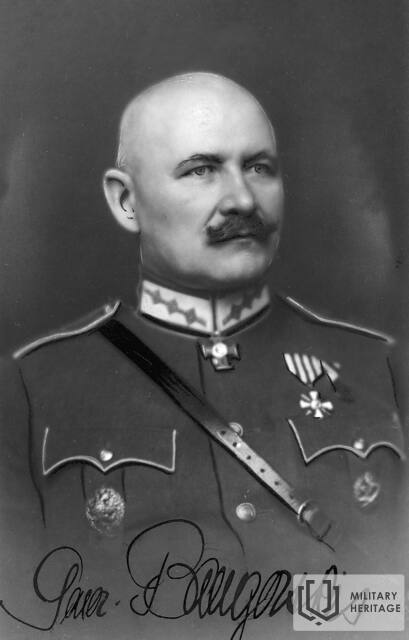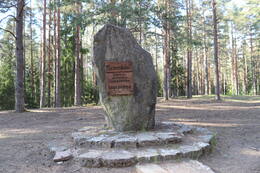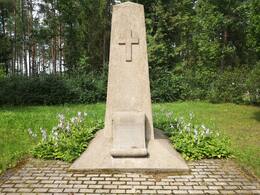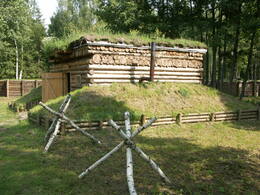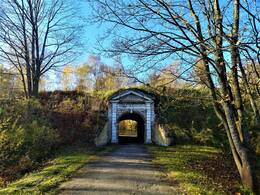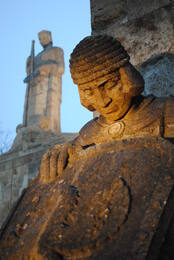Generolas Rudolfas Bangerskis
I WW1, I Nepriklausomybės karai, Baltijos šalių nepriklausomybė, II WW2
Rudolfas Bangerskis gimė 1878 07 21 Līčakroge, Taurupės valsčiuje. Mokėsi Zaubės pagrindinėje mokykloje ir Jaunjelgavos miesto mokykloje. 1895 metais įstojo į kariuomenę, tarnavo ir Rygoje, ir Sankt Peterburge.
1914 m., prasidėjus I pasauliniam karui, R. Bangerskis grįžo į 36-ąjį pėstininkų pulką kuopos vadu ir jau 1914 m. gruodį gavo kapitono laipsnį. 1915 m. rugpjūtį pradėjus formuoti latvių šaulių batalionus, R. Bangerskis buvo paskirtas 1-ojo Daugavgrivos latvių šaulių bataliono vadu. 1916 metų spalį R. Bangerskis buvo paaukštintas į pulkininkus leitenantus, o po dviejų mėnesių - į pulkininkus.
1916 m. gruodžio mėn. R. Bangerskis tapo laikinai einantis 2-ojo Rygos latvių šaulių pulko vadą, o Kalėdų kautynių metu – jungtinės latvių šaulių divizijos štabo viršininku „1917 m. sausio 17 d. mūšyje prie Ložmetējkalno Bangerskis asmeniškai vykdė žvalgybą ir vadovavo fronto ugniai. taip labai prisidėdamas prie priešo pozicijų atkovojimo“. Už šiuos nuopelnus 1923 metais R. Bangerskis buvo apdovanotas III laipsnio Latvijos Lāčplėsio karo ordinu Nr. 1627 m.
1924 metų vasarį R. Bangerskis pradėjo tarnybą Latvijos kariuomenėje su pulkininko laipsniu ir nuo 1924 m. gruodžio iki 1925 m. gruodžio ir nuo 1926 m. gruodžio iki 1928 m. sausio R. Bangerskis buvo karo ministras.
Karo ministras J. Balodis straipsnyje „Pagarba generolui R. Bangerskiui“ laikraštyje „Rīts“ Nr. 76 (1937 03 17) gyrė R. Bangerskį: „Jis buvo vienas iškiliausių latvių šaulių pulkų kūrėjų ir vadų garsiose kautynėse. Jo turtingi koviniai nuotykiai ir išgyvenimai bei didžiulis ryžtas mums atnešė negailestingumą ir rūpestį jos formavimas“.
Antrojo pasaulinio karo metais, vokiečių okupacijos metais 1942–1943 m., R. Bangerskis buvo savivaldos generalinio teisingumo direktorato referentas, vėliau ir Latvijos legiono generalinis inspektorius bei SS grupierius. 1945 metų vasario 20 dieną Potsdame (Vokietija) R. Bangerskis buvo išrinktas Latvijos nacionalinio komiteto prezidentu. Nuo 1945 metų birželio iki 1946 metų gruodžio R. Bangerskis buvo sulaikytas britų. Išėjęs į laisvę gyveno Oldenburge, Vokietijoje. Mirė 1958 metų vasario 25 dieną. Perlaidotas 1995 03 16 Rygoje, Brolių kapinėse.
Per savo karinę karjerą R. Bangerskis gavo Latvijos III laipsnio Lāčplės karo ordiną, II laipsnio Trijų žvaigždžių ordiną, Latvijos gynėjų kryžių, Prancūzijos Garbės legioną, Estijos Laisvės kryžių, Lietuvos I laipsnio Vito Kryžiaus ordiną, Rusijos Šv. Juris Sword, taip pat kiti aukšti apdovanojimai iš Latvijos, Estijos, Lietuvos, Lenkijos, Rusijos ir Vokietijos.
Daugiau informacijos šaltinių
Šaltinis: Latvijos karo muziejus. Generolas Rudolfas Bangerskis (1878–1958). Prieiga: http://www.karamuzejs.lv/lv/Izstades/generali/generalis_BangerskisRudolfs.aspx [žiūrėta 2021 10 21]
Susijusi laiko juosta
Susijusios vietos
Kulkosvaidžio kalnas Tyrelio pelkėje
Kulkosvaidžio kalnas (Ložmetėjkalnas) yra Jelgavos apy linkėse, Valgundės seniūnijoje, šalia automagistralės A9. Tai Pirmojo pasaulinio karo mūšių vieta ir vienintelis vals tybinės reikšmės kultūrinis ir istorinis draustinis Latvijoje. Ložmetėjkalnas yra ant Ilgosios kopos, priklausančios Nor dekių–Kalnciemo kopagūbriui. Pavadinimas atsirado tais laikais, kai čia buvo įrengti neįveikiami Vokietijos kariuo menės įtvirtinimai, ginami sunkiaisiais kulkosvaidžiais. Kalėdų mūšiai – vienas žinomiausių ir dramatiškiausių Pirmojo pasaulinio karo įvykių Latvijos istorijoje. 1917 m. Ložmetėjkalną puolė ir užėmė Rusijos kariuomenės latvių šaulių bei sibiriečių daliniai. Jie paėmė į nelaisvę apie 600 priešo karių ir užgrobė vertingų trofėjų. Patys šauliai tvirtino, kad būtent jie nusipelnė vadintis šios aukštumos užkariautojais. Kulkosvaidžio kalno (Ložmetėjkalno) apylinkėse yra išlikę atminimo ženklai ir kitų čia vykusių mūšių liudijimai. Kas met sausio mėnesį čia vyksta renginiai, skirti Kalėdų mūšių atminimui. Ši vieta tapo latvių šaulių didvyriškumo ir narsos simboliu. Čia pastatytas 27 m aukščio apžvalgos bokštas, nuo kurio atsiveria Kalėdų mūšių vietos vaizdas.
Kalėdinių mūšių memorialas Antinu brolių kapinėse
Įsikūręs Babytės rajone, pakelėje, netoli buvusių Antinių namų ir senojo vaistų sandėlio.
Antinių arba Tyrelių karių kapinės buvo įkurtos Pirmojo pasaulinio karo metu. Šioje teritorijoje buvo Rusijos imperijos armijos gynybinės pozicijos. 1917 m., per Kalėdų mūšius, netoliese buvo įsikūręs 5-ojo Žemgalės latvių šaulių pulko štabas, ligoninė su vaistų sandėliu.
1917 m., sausio 5-osios ir 6-osios naktį, apšviečiant aštuoniems didžiuliams laužams, su karine pagarba buvo palaidoti 105 5-ojo žiemgalių latvių šaulių pulko kovotojai. Jie žuvo mūšiuose su vokiečių armija arba mirė nuo žaizdų. Laidojimo ceremonijai vadovavo pulko vadas Jukumas Vācietis. Vėlesniais metais kapinėse buvo laidojami ir kitų Rusijos armijos dalinių kareiviai. 1925 m. kapinėse atidengtas architekto Eiženo Laubės paminklas, o teritorija apželdinta. Informacijos apie 3800 kapinėse palaidotų kareivių randama daug kur, tačiau ją reikėtų laikyti mažai tikėtina ir nepatikrinta.
Kalėdų mūšių muziejus
Muziejus, įsikūręs sodyboje „Mangaļi“ Jelgavos apylinkėse, Valgundės seniūnijoje, yra Latvijos karo muziejaus filialas. Jis atidarytas 2005 m. toje vietoje, kurioje per Pirmąjį pa saulinį karą vyko Kalėdų mūšiai. Šiose vietose iki šiol tebėra išlikę išskirtiniai Pirmojo pasaulinio karo įtvirtinimai. Kalėdų mūšių muziejaus ekspozicija yra įrengta autentiškoje vieto je po atviru dangumi. Čia galima pamatyti rekonstruotą įtvirtinimų sistemos fragmentą – lauko slėptuvę ir dalį pir mosios vokiečių gynybos linijos, vadinamos „vokiečių pyli mu“. Tai vienintelis tokio pobūdžio objektas Baltijos šalyse. Kalėdų mūšiai – vienas žinomiausių ir dramatiškiausių Pir mojo pasaulinio karo įvykių Latvijoje. Jie užima ypatingą vietą latvių karo ir kultūros istorijoje. Intensyvūs mūšiai truko šešias dienos ir pareikalavo daug aukų. Šie įvykiai dažniau siai siejami su latvių šaulių puolimu prieš Vokietijos kariuo menę, vykusiu ypač atšiauriomis ir nepalankiomis žiemos sąlygomis. Tai buvo pirmas kartas, kai didelio masto puo limas vyko be artilerijos palaikymo. Šiuo metu muziejuje eksponuojami mūšių vietose rasti radi niai. Vidaus ekspozicija lankoma nustatytu laiku, o po atvi ru dangumi esančių įtvirtinimų ekspoziciją galima apžiūrėti kiekvieną dieną. Apylinkėse sudaryti turistiniai maršrutai ir įrengti pažintiniai takai.
Daugavgryvos tvirtovė
Daugavgryvos tvirtovė (įėjimas iš Birzės gatvės) yra Daugavgryvos saloje, kur Bulupės upė įteka į Dauguvos upę. Tvirtovė buvo pastatyta XVII a., siekiant apsiginti nuo priešų, judančių Rygos kryptimi, kuri buvo svarbus administracinis, prekybos ir gamybos centras. Vėliau ji tapo pagrindiniu Latvijos armijos pakrantės gynybos įtvirtinimu su keliais atramos taškais. Ši gynybinė įtvirtinimų sistema yra vienas vertingiausių Latvijos karinio paveldo objektų. Ši tvirtovė yra Latvijos karinės istorijos liudininkė. Pavyzdžiui, Krymo karo metu (1853–1856 m.) čia buvo mokomos Latvijos ir Estijos patrankinių valčių įgulos. Pagrindinis šių dalinių tikslas buvo ginti vietos uostus ir pakrantę nuo britų karinio jūrų laivyno atakų. Pirmojo pasaulinio karo metu čia buvo suformuotos Daugavgryvos milicijos kuopos. Tai buvo pirmieji Latvijos koviniai daliniai, atsiradę dar anksčiau nei Latvijos šauliai. Šiandien galima pamatyti tvirtovės teritoriją. Netoliese yra Kometfortas ir Pajūrio gamtos parkas, o kitoje Dauguvos pusėje – Mangaļsalos įtvirtinimai.
Brothers' Cemetery in Riga
Riga Brothers’ Cemetery is located in the northern district of Riga. The cemetery extends over an area of 9 ha and is the most outstanding and significant memorial ensemble in Latvia dedicated to the fallen Latvian soldiers. About 3,000 soldiers are buried here. The Brothers’ Cemetery was created during World War I after the first three Latvian Riflemen, who fell in Tīreļpurvs in the battle against the German Army, were buried here. Later Latvian soldiers who had died in other battles and wars would also be buried in the Brothers’ Cemetery. The memorial is based on the design of the sculptor Kārlis Zāle, and is the first memorial ensemble in Europe with such landscape, architecture and sculptural value. It uses elements typical to the Latvian landscape, traditional farmsteads, Latvian folklore and history that praise the characteristics of soldiers and tell the story of the way of the soldier. The memorial was unveiled in 1936 and it has three parts: ‘The Road of Though’ which is a 250 m long alley, ‘Terrace of Heroes’ with the Altar of the Sacred Flame and ensemble the Sacred Oak Grove, and the burial ground with the Latvian wall and a memorial of a mother with her fallen sons.
Susijusi istorija
Apie kalėdines kovas
Kalėdinės kautynės baigėsi sausio 11. Trečią mūšio dieną latvių šauliams pavyko užimti stipriai įtvirtintą vokiečių kariuomenės poziciją – Ložmetējkalni. Kalėdinių kovų kaina buvo labai didelė. Šimtai Latvijos ir kitų Rusijos armijos karių žuvo bandydami išmušti vokiečius iš savo pozicijų. Pasakotojas vaizdingai aprašo mūšio lauko scenas pasibaigus kalėdinėms kautynėms.
Apie Daugavgrivos tvirtovę
Pasakotojas aprašo įvykį Daugavgrivos tvirtovėje I pasaulinio karo metais, kai ją subombardavo vokiečių dirižablis. Tvirtovė buvo vienas iš strateginių objektų, išlaikęs savo svarbą iki Antrojo pasaulinio karo pabaigos.




